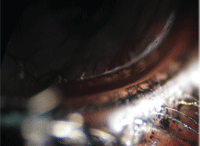Q: A 24-year-old female presented two weeks ago with bacterial conjunctivitis. This was her third such presentation in as many years, usually right after the holidays. She wondered if she had somehow picked it up at a New Year’s Eve party. How do I answer this one?

A: The annual recurrence might be the clue. “Ask if she had a makeover at a department store makeup counter before the party,” says Elyse L. Chaglasian, O.D., associate professor at the Illinois College of Optometry.
“Makeup counters are swimming with bacteria,” she says. It doesn’t matter if you go to Neiman Marcus or Kohl’s. “High-end or low-end, they’re all guilty.”
In fact, a two-year double blind study by Elizabeth Brooks, D.P.M., of Rowan University tested makeup samples from 20 companies and found, depending on the day of the week, up to 100% of samples were contaminated with Staph., Strep. and even E. coli bacteria.
“It’s risky enough to share makeup with your sister or your girlfriend, but it can be truly hazardous to go to the makeup counter at the department store,” Dr. Chaglasian says.
So, in addition to the usual differential diagnosis for bacterial conjunctivitis, ask these questions to a female patient who comes in with such an ocular infection:
• Have you switched makeup recently? “The patient could be having an allergic or a sensitivity reaction to either a preservative or an ingredient in the makeup,” she says.
And, hypoallergenic on the label doesn’t mean that it’s safe. “It might mean it’s less allergenic, but the FDA has no requirements on the claims that companies make, so there’s no guarantee that a sensitive patient won’t have problems. Same thing goes when it says it has ‘natural’ ingredients.”

Patients should take off eye makeup every night, using a makeup wipe.
• Have you been sharing makeup with anyone? To prevent the possibility of infection, recommend not sharing makeup with friends or family members.
Also, take precautions at the makeup counter. “Ask the salesperson to use a fresh tester each time and to use alcohol to clean brushes. Or bring your own disposable applicators or Q-tips,” Dr. Chaglasian says. “If it’s cream makeup, be sure to remove the top layer with a tissue. Also, avoid lotions that come in a jar—opt for a squeeze bottle or a pump.”
• When was the last time you replaced your makeup? “Mascara, eyeliner and eye shadow should be replaced every three to six months,” she says. “But I can tell you firsthand that women don’t do that. They’ll use it to the bitter end. Makeup does have preservatives, but the more you use it and expose it to air, the faster the preservatives break down.”
If your makeup is contaminated, throw it away or it will keep re-infecting your eyes. “If it changes color or if it smells, toss it out right away.”
• How do you apply your eyeliner? “Instruct patients to apply it only on the outside of the lid margin, not on the inside closest to the eye,” she says. “Eyeliner can clog the meibomian glands, leading to dry eye issues and possible hordeola or chalazion formation.”
• Do you take your makeup off every day with a specified eye makeup remover? “A lot of women don’t remove their makeup, while others still use baby oil, Vaseline or soap and water—but these don’t remove all the makeup,” Dr. Chaglasian says. “I recommend pre-moistened eye makeup remover pads or non-oily solution.”
Male doctors may be unaware of the issues surrounding makeup hygiene or may feel uncomfortable discussing makeup with female patients. “In the ophthalmology practice that I’m in, we have a sample jar of non-oily eye makeup remover pads. Typically, the male doctor will bring in a female technician to discuss with the patient how to properly remove makeup from the eyes.”

